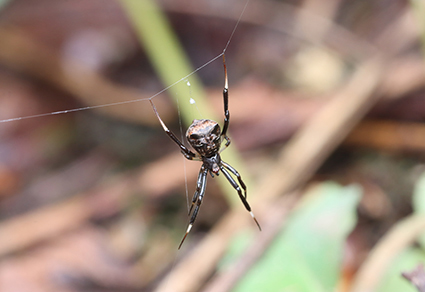Abstract
Based on morphological evidence and prior molecular phylogenetic results by Liu et al., a new genus, Asiopisinus gen. nov., is described from East Asia. The new genus comprises A. cheni sp. nov. (♂♀) as the type species, along with seven species transferred from Episinus Walckenaer, 1809: A. anfu (Liang, Liu, Yin & Yu, 2025) comb. nov., A. baoshanensis (Liu, Irfan & Peng, 2019) comb. nov., A. implicatus (Liang, Liu, Yin & Yu, 2025) comb. nov., A. nubilus (Yaginuma, 1960) comb. nov., A. ornithorhynchus (Liu, Agnarsson, Liu & Zhu, 2022) comb. nov., A. pseudonubilus (Liang, Liu, Yin & Yu, 2025) comb. nov., and A. yoshidai (Okuma, 1994) comb. nov.. The male of A. implicatus (Liang, Liu, Yin & Yu, 2025) comb. nov. is described for the first time. In addition, remarks and photos of some Chinese Episinus species are provided. The distribution records of all Asiopisinus gen. nov. species have been mapped.
References
- Agnarsson, I. (2004) Morphological phylogeny of cobweb spiders and their relatives (Araneae, Araneoidea, Theridiidae). Zoological Journal of the Linnean Society, 141 (4), 447–626. https://doi.org/10.1111/j.1096-3642.2004.00120.x
- Agnarsson, I., Coddington, J.A. & Knoflach, B. (2007) Morphology and evolution of cobweb spider male genitalia (Araneae, Theridiidae). Journal of Arachnology, 35 (2), 334–395. https://doi.org/10.1636/SH-06-36.1
- Arnedo, M.A., Coddington, J., Agnarsson, I. & Gillespie, R.G. (2004) From a comb to a tree: phylogenetic relationships of the comb‐footed spiders (Araneae, Theridiidae) inferred from nuclear and mitochondrial genes. Molecular phylogenetics and evolution, 31 (1), 225–245. https://doi.org/10.1016/S1055-7903(03)00261-6
- Court, D.J. (1982) Spiders from Tawhiti Rahi, Poor Knights Islands, New Zealand. Journal of the Royal Society of New Zealand, 12, 359–371. https://doi.org/10.1080/03036758.1982.10415342
- Durán-Barrón, C.G., Rosas, M.V. & Contreras-Ramos, A. (2013) Phylogenetic relationships of the comb‐footed spider subfamily Spintharinae (Araneae, Araneoidea, Theridiidae), with generic diagnoses and a key to the genera. Zootaxa, 3666 (2), 171–193. https://doi.org/10.11646/zootaxa.3666.2.4
- Gregorič, M., Yu, K.P., Ravelojaona, J., Agnarsson, I. & Kuntner, M. (2024) A perilous Malagasy triad: a spider (Vigdisia praesidens, gen. and sp. nov.) and an ant compete for termite food. New Zealand Journal of Zoology, 1–12. https://doi.org/10.1080/03014223.2024.2373185
- Jin, C. (2018) Theridiidae, Ctenidae, Liocranidae. In: Zhang, F. & Xue, X.F. (Eds.), Fauna of Tianmu Mountain. Volume II. Arachnida. Araneae Eriophyoidea. Zhejiang University Press, Hangzhou, pp. 11–33 + 79–80 + 90–91, pls. 2–7 + 17 + 19.
- Kim, S.T. (2021) Spiders V. Arthropoda: Arachnida: Araneae: Theridiidae, Amaurobiidae, Eresidae, Zoropsidae, Anyphaenidae. Invertebrate Fauna of Korea, 21 (47), 1–230.
- Knoflach, B. & Pfaller, K. (2004) Kugelspinnen – eine Einführung (Araneae, Theridiidae). In: Thaler, K. (Ed.), Diversität und Biologie von Webspinnen, Skorpionen und anderen Spinnentieren. Denisia, 12, pp. 111–160.
- Knoflach, B. & Thaler, K. (2000) Notes on Mediterranean Theridiidae (Araneae) - I. Memorie della Società Entomologica Italiana, 78, 411–442.
- Liang, Y., Liu, J., Yin, H.Q. & Xu, X. (2025) On new spider species of the genus Episinus (Araneae, Theridiidae) from China and proposal of five species groups. Biodiversity Data Journal, 13 (e144222), 1–19. https://doi.org/10.3897/BDJ.13.e144222
- Liu, F., Irfan, M. & Peng, X.J. (2019) Two new species of Theridiidae (Arachnida, Araneae) from Yunnan province, China. Journal of Asia-Pacific Biodiversity, 12 (3), 394–399. https://doi.org/10.1016/j.japb.2019.01.012
- Liu, F.J., Agnarsson, I., Liu, J. & Zhu, Y. (2022) Description and phylogenetic analysis of two new Episinus (Araneae, Theridiidae) species from China. ZooKeys, 1125, 33–46. https://doi.org/10.3897/zookeys.1125.90212
- Liu, J., May-Collado, L.J., Pekár, S. & Agnarsson, I. (2016) A revised and dated phylogeny of cobweb spiders (Araneae, Araneoidea, Theridiidae): A predatory Cretaceous lineage diversifying in the era of the ants (Hymenoptera, Formicidae). Molecular Phylogenetics and Evolution, 94, 658–675. https://doi.org/10.1016/j.ympev.2015.09.023
- Liu, J.X., Liang, Y., Yin, H.Q. & Xu, X. (2025) Molecular phylogeny of the hadrotarsine genera from East Asia provides new insights for their affinities and positions within cobweb spiders (Araneae: Theridiidae: Hadrotarsinae). Organisms Diversity and Evolution. [published online] https://doi.org/10.1007/s13127-025-00670-5
- Okuma, C. (1994) Spiders of the genera Episinus and Moneta from Japan and Taiwan, with descriptions of two new species of Episinus (Araneae: Theridiidae). Acta Arachnologica, 43 (1), 5–25. https://doi.org/10.2476/asjaa.43.5
- Rodrigues, E.N.L., Rodrigues, P.E., Brescovit, A.D. & Koh, J.K. (2022) An update on the phylogeny of Spintharinae with analysis based on morphological characters and taxonomy of Janula (Araneae, Theridiidae). Organisms Diversity & Evolution, 22 (3), 749–787. https://doi.org/10.1007/s13127-022-00547-x
- Song, D.X., Zhu, M.S. & Chen, J. (1999) The spiders of China. Hebei Science and Technology Publishing House, Shijiazhuang, 640 pp.
- WSC (2025) World Spider Catalog. Natural History Museum Bern, [online]. Available from: http://wsc.nmbe.ch (accessed 3 June 2025)
- Wunderlich, J. (2008) On extant and fossil (Eocene) European comb‐footed spiders (Araneae: Theridiidae), with notes on their subfamilies, and with descriptions of new taxa. Beiträge zur Araneologie, 5, 140–469 + 792–794, 796–800, 803, 819–859.
- Yaginuma, T. (1960) Spiders of Japan in colour. Hoikusha, Osaka, 186 pp.
- Yin, C.M., Peng, X.J., Yan, H.M., Bao, Y.H., Xu, X., Tang, G., Zhou, Q.S. & Liu, P. (2012) Fauna Hunan: Araneae in Hunan, China. Hunan Science and Technology Press, Changsha, 1590 pp.
- Yoshida, H. (1983) Spiders from Taiwan IV. The genus Episinus (Araneae: Theridiidae). Acta Arachnologica, 31 (2), 73–77. https://doi.org/10.2476/asjaa.31.73
- Yoshida, H. (1985) A new spider of the genus Episinus (Araneae, Theridiidae) from Nagano Prefecture, central Japan. Bulletin of the Biogeographical Society of Japan, 40, 25–30.
- Yoshida, H. (2001) A revision of the Japanese genera and species of the subfamily Theridiinae (Araneae: Theridiidae). Acta Arachnologica, 50 (2), 157–181. https://doi.org/10.2476/asjaa.50.157
- Zhu, M.S. (1998) Fauna Sinica: Arachnida: Araneae: Theridiidae. Science Press, Beijing, 436 pp.


